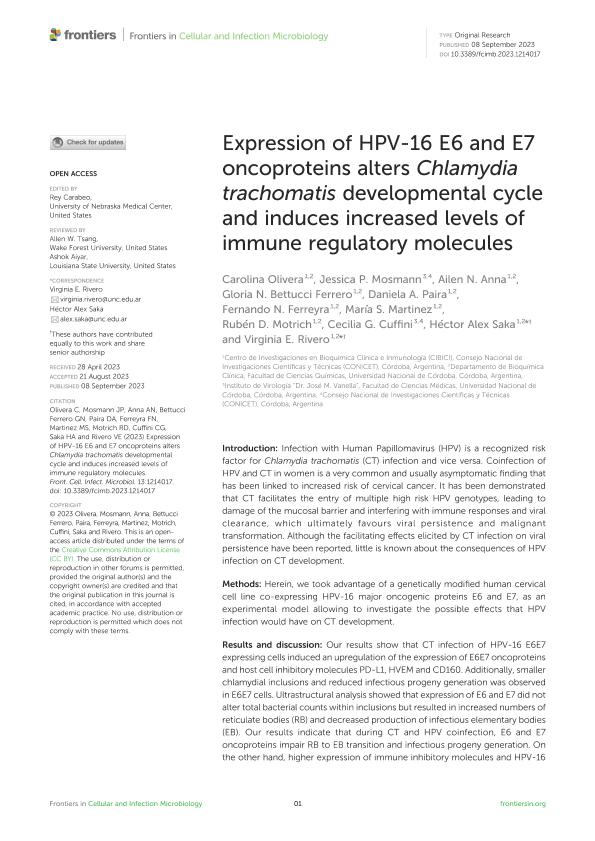Artículo
Expression of HPV-16 E6 and E7 oncoproteins alters Chlamydia trachomatis developmental cycle and induces increased levels of immune regulatory molecules
Olivera, Carolina ; Mosmann, Jessica Paola
; Mosmann, Jessica Paola ; Anna, Ailen Nair; Bettucci Ferrero, Gloria Nazarena
; Anna, Ailen Nair; Bettucci Ferrero, Gloria Nazarena ; Paira, Daniela Andrea
; Paira, Daniela Andrea ; Ferreyra, Fernando N.; Martinez, María Sol; Motrich, Ruben Dario
; Ferreyra, Fernando N.; Martinez, María Sol; Motrich, Ruben Dario ; Cuffini, Cecilia Gabriela
; Cuffini, Cecilia Gabriela ; Saka, Hector Alex
; Saka, Hector Alex ; Rivero, Virginia Elena
; Rivero, Virginia Elena
 ; Mosmann, Jessica Paola
; Mosmann, Jessica Paola ; Anna, Ailen Nair; Bettucci Ferrero, Gloria Nazarena
; Anna, Ailen Nair; Bettucci Ferrero, Gloria Nazarena ; Paira, Daniela Andrea
; Paira, Daniela Andrea ; Ferreyra, Fernando N.; Martinez, María Sol; Motrich, Ruben Dario
; Ferreyra, Fernando N.; Martinez, María Sol; Motrich, Ruben Dario ; Cuffini, Cecilia Gabriela
; Cuffini, Cecilia Gabriela ; Saka, Hector Alex
; Saka, Hector Alex ; Rivero, Virginia Elena
; Rivero, Virginia Elena
Fecha de publicación:
08/2023
Editorial:
Frontiers Media
Revista:
Frontiers in Cellular and Infection Microbiology
ISSN:
2235-2988
Idioma:
Inglés
Tipo de recurso:
Artículo publicado
Clasificación temática:
Resumen
Introduction: Infection with Human Papillomavirus (HPV) is a recognized risk factor for Chlamydia trachomatis (CT) infection and vice versa. Coinfection of HPV and CT in women is a very common and usually asymptomatic finding that has been linked to increased risk of cervical cancer. It has been demonstrated that CT facilitates the entry of multiple high risk HPV genotypes, leading to damage of the mucosal barrier and interfering with immune responses and viral clearance, which ultimately favours viral persistence and malignant transformation. Although the facilitating effects elicited by CT infection on viral persistence have been reported, little is known about the consequences of HPV infection on CT development. Methods: Herein, we took advantage of a genetically modified human cervical cell line co-expressing HPV-16 major oncogenic proteins E6 and E7, as an experimental model allowing to investigate the possible effects that HPV infection would have on CT development. Results and discussion: Our results show that CT infection of HPV-16 E6E7 expressing cells induced an upregulation of the expression of E6E7 oncoproteins and host cell inhibitory molecules PD-L1, HVEM and CD160. Additionally, smaller chlamydial inclusions and reduced infectious progeny generation was observed in E6E7 cells. Ultrastructural analysis showed that expression of E6 and E7 did not alter total bacterial counts within inclusions but resulted in increased numbers of reticulate bodies (RB) and decreased production of infectious elementary bodies (EB). Our results indicate that during CT and HPV coinfection, E6 and E7 oncoproteins impair RB to EB transition and infectious progeny generation. On the other hand, higher expression of immune inhibitory molecules and HPV-16 E6E7 are cooperatively enhanced in CT-infected cells, which would favour both oncogenesis and immunosuppression. Our findings pose important implications for clinical management of patients with HPV and CT coinfection, suggesting that screening for the mutual infection could represent an opportunity to intervene and prevent severe reproductive health outcomes, such as cervical cancer and infertility.
Archivos asociados
Licencia
Identificadores
Colecciones
Articulos(CIBICI)
Articulos de CENTRO DE INV.EN BIOQUI.CLINICA E INMUNOLOGIA
Articulos de CENTRO DE INV.EN BIOQUI.CLINICA E INMUNOLOGIA
Articulos(INIMEC - CONICET)
Articulos de INSTITUTO DE INV. MEDICAS MERCEDES Y MARTIN FERREYRA
Articulos de INSTITUTO DE INV. MEDICAS MERCEDES Y MARTIN FERREYRA
Citación
Olivera, Carolina; Mosmann, Jessica Paola; Anna, Ailen Nair; Bettucci Ferrero, Gloria Nazarena; Paira, Daniela Andrea; et al.; Expression of HPV-16 E6 and E7 oncoproteins alters Chlamydia trachomatis developmental cycle and induces increased levels of immune regulatory molecules; Frontiers Media; Frontiers in Cellular and Infection Microbiology; 13; 8-2023; 1-15
Compartir
Altmétricas



